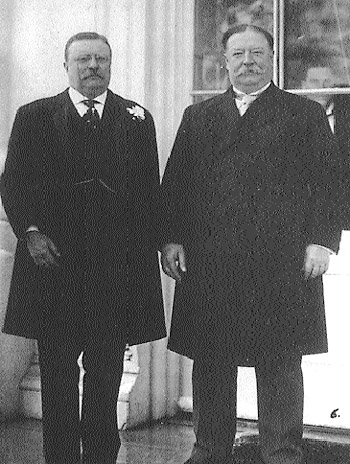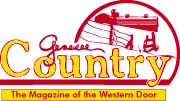
William Howard Taft (right) followed Rough
Rider Theodore
Roosevelt into the White House. Both campaigned in Rochester.
Vice
presidential candidate Teddy Roosevelt visited Geneseo during the 1900 campaign,
praising his Spanish War comrade 'Young Jim' Wadsworth, who mustered a mounted
marching club and led it through 300 miles of electioneering.
Andrew Johnson, Ulysses S. Grant and William Seward all spoke in Rochester during
1865. Retired President Grant, along with Roscoe Conklin, made Republican speeches
in 1880, followed the next day by Gen. McClellan, boosting the Democrats. Grover
Cleveland and James G. Blaine both visited in 1883, assisting with the city's
50th anniversary.
In 1896, a prairie wind swept the city,
as William Jennings Bryan proclaimed the gospel of free silver and populism. He
packed the largest crowd of the campaign into Jones Park, but even the Democratic
papers took fright at the Boy Orator's "radical" notions. Bryan only
polled two-thirds of McKinley's vote.
Republicans like William
Howard Taft, Charles Evans Hughes, Teddy Roosevelt and Calvin Coolidge paraded
across Rochester podiums, often invited by the Chamber of Commerce or by the Grand
Army of the Republic, cynically known in Democratic circles as the "Grand
Army of the Republicans." The rural districts got much shorter shrift.
But
color and drama could still be wrung from the Genesee Country. Vice presidential
candidate Teddy Roosevelt visited Geneseo during the 1900 campaign, praising his
Spanish War comrade 'Young Jim' Wadsworth, who mustered a mounted marching club
and led it through 300 miles of electioneering.
Rochester
publisher Frank Gannett made an ill-advised presidential try in 1940, fielding
a parade of elephants and garnering 33 votes at the Republican convention. How
many pounds would that come to per delegate?
Franklin D. Roosevelt,
escorted by the Genesee Cavalry, campaigned in Rochester in 1921, as well he might.
It was from the state convention in Rochester that Al Smith repeatedly called
Roosevelt in 1928, determined to press the governor's race on him while Smith
campaigned for President.
FDR was consistently unavailable,
so Smith turned to Eleanor Roosevelt (a power in her own right at the convention),
persuading her to call Warm Springs. Eleanor got her husband on the line, handed
the phone to Smith, and ran for a train. Only later would she learn that Smith
had set Franklin back on the path to the White House.
Genesee
Country politics by 1928 had come a long way since 1851, when the superintendent
of the Erie Railroad blocked the ceremonial first train with ties, refusing to
clear the track until Daniel Webster made a speech in Cuba. But even in 1928 some
hardy souls preserved the rollicking frontier spirit.
Radio
audiences listening to the Democratic National Convention were mystified, and
delegates annoyed, by loud whistle blasts sounding at odd moments.
Folks
around Wheatland, on the other hand, were delighted. It was the familiar sound
of William C. Page, ";the Sage of Wheatland" and former county chairman,
blowing his dog whistle. The cabin and cider boys would have cackled with approval.
Kirk House is curator of the Glenn Curtiss Museum in Hammondsport.

